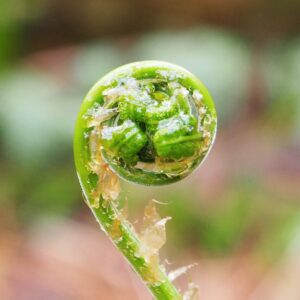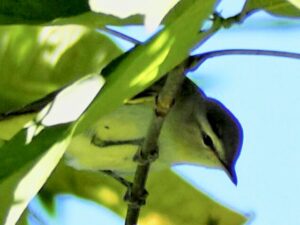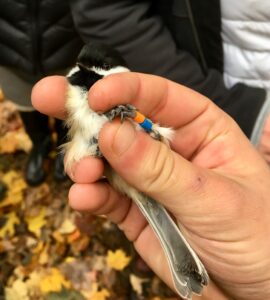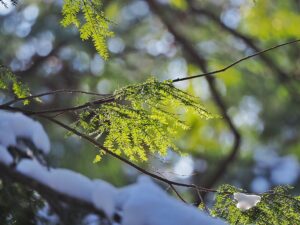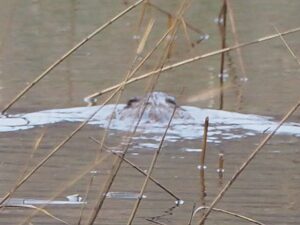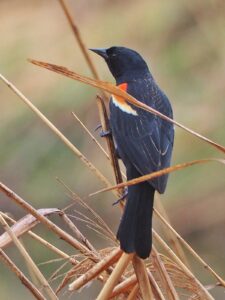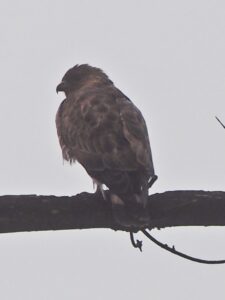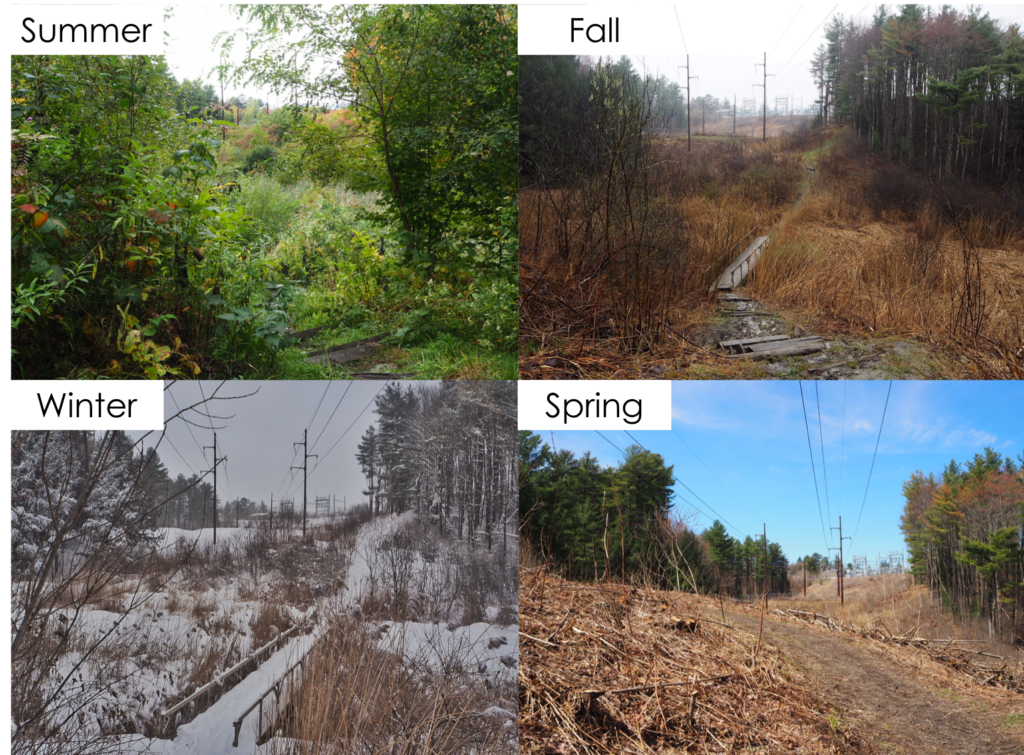
As of visiting my phenology spot for the final time this semester, I am met with a sense of discovery and closure. Being able to better read the landscape and observe different natural and cultural factors I saw both old and new phenomenon. For example, one staple to my phenology spot throughout this year has been the Black-Capped Chickadee. State bird of my home state of Massachusetts these birds have been the first creature I meet through its calls, chirps, dangling off tree branches, or even fly ever so close to me. These chickadees have not only been the ambassador to the natural world for me, but to all those that enter Centennial Woods. Despite harsh winter winds, introduced invasive phragmites, and the yelling of school children these chickadees are still there to greet you. Anyone including hikers, botanists, dog walkers, families, and the average joe can identify and enjoy these feathered friends. To a greater extent, this appreciation towards chickadees can be found in ornithologists who have placed bird feeders all around my phenology spot to see if any of their tagged chickadees have returned. This is one of the amazing species that occupy this spot and have adjusted to natural and cultural factors.
 As much as the chickadee is a symbol of natural and cultural factors, my phenology spot have been affected by these factors. Based on the histories of indigenous, farming, recreational, and management purposes this landscape has undergone major changes. As of 2019, the main influential cultural forces are management and recreational factors. In terms of management, this location is an active natural area managed by UVM that balances the usage of powerlines and a retention pond. Natural phenomenon interacts with these cultural factors such as the retention pond improving water quality and act as habitat, while the powerlines act as a corridor for wildlife and hikers. In terms of recreation, my phenology spot is meant as a natural area for hiking and other forms of appreciation towards nature. For me, this has taken the form of photography in that taking photos have given me the means to share narratives of this landscape and its usage. For example, I have been able to show through images the dynamic transformations of my phenology spot throughout the year.
As much as the chickadee is a symbol of natural and cultural factors, my phenology spot have been affected by these factors. Based on the histories of indigenous, farming, recreational, and management purposes this landscape has undergone major changes. As of 2019, the main influential cultural forces are management and recreational factors. In terms of management, this location is an active natural area managed by UVM that balances the usage of powerlines and a retention pond. Natural phenomenon interacts with these cultural factors such as the retention pond improving water quality and act as habitat, while the powerlines act as a corridor for wildlife and hikers. In terms of recreation, my phenology spot is meant as a natural area for hiking and other forms of appreciation towards nature. For me, this has taken the form of photography in that taking photos have given me the means to share narratives of this landscape and its usage. For example, I have been able to show through images the dynamic transformations of my phenology spot throughout the year.
- This emerging ostrich fern is one of many that are emerging now. Also known as fiddleheads they are a delicacy and a sign of spring.
- Taken in August this Red-Eyed Vireo is perched in a tree. It is foraging with other vireos preparing for its southward pilgrimage.
- Taken in November a Chickadee Banding was conducted at my phenology spot. Banded with a unique set of colored bands this chickadee’s whereabouts can be tracked.
- Taken in February this eastern hemlock is withstanding this long winter. As a conifer its needles maintain its vibrant colors despite the weight of snow and blistering temperatures.
Once arriving in August, my phenology spot was booming with vibrant scarlet sumac bobs and luscious herbaceous plants luring in citizens of Burlington to seek an escape into nature. As one of these citizens trying to escape into the outdoors, I was greeted not only by chickadees but, Red-Eyed Vireos, American Redstarts, Ruby-Throated Hummingbirds, and more. However, as autumn rolled in, the colors of this location slowly dimish by colder temperatures leading to the loss of leaves, Vermont’s migrant bird species, and hikers. Despite the approaching dormancy chickadees still persisted as seen in banding programs conducted by UVM. However, dormancy did still arrive with large amounts of snowfall and bitter temperatures. As seen in Febuary, this landscape seemed barren under a blanket of snow, yet life still prevailed as seen through naturalists tracking mammals and the green vitality of eastern hemlocks and other conifers. Soon after with increasing amounts of rain and rising temperatures this blanket of snow started to retreat, while spring was aproaching ever so slowy. However, to my surprise, this dynamic landscape came to a halt by early April with the clearing of woody vegetation of my spot. Expecting new spring growth manegment services cleared for existing powerlines. This to an extent did alienate me from my spot, yet has been able to introduce me to new discoveries. This clearing has made me and others able to explore new areas such as the much-hidden retention pond where I was greeted with emerging ostrich ferns from the Earth.
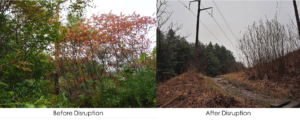 For the first time, I was able to explore this area and to my surprise, I was able to discover some new friends. Once entering the open gate I was greeted not only by chickadees but, phoebes, red-winged blackbirds, and a lonely beaver. As much as this area may seem barren with fallen sumac limbs, life still persists. This beaver for a moments notice was swimming along the shore of the retention pond and quickly submerged itself after being noticed. This human development aimed in the preservation of water quality and habitat ironically became a habitat for this beaver. As much as powerline companies cleared this landscape, retention ponds improve act as habitat, and hikers traverse the landscape, nature adapts with time. For me, this appreciation of nature to adapt to both cultural and natural means through time is phenology to me.
For the first time, I was able to explore this area and to my surprise, I was able to discover some new friends. Once entering the open gate I was greeted not only by chickadees but, phoebes, red-winged blackbirds, and a lonely beaver. As much as this area may seem barren with fallen sumac limbs, life still persists. This beaver for a moments notice was swimming along the shore of the retention pond and quickly submerged itself after being noticed. This human development aimed in the preservation of water quality and habitat ironically became a habitat for this beaver. As much as powerline companies cleared this landscape, retention ponds improve act as habitat, and hikers traverse the landscape, nature adapts with time. For me, this appreciation of nature to adapt to both cultural and natural means through time is phenology to me.
- This Eastern Phebe is perched on a broken phragmites. Last observed here in November this returning migrant has decided to come back to this location for the summer.
- This illusive beaver was swimming along side of the retention pond. Identified by its large size and slapping its paddle-like tail against the water this was beaver, which looks similar to the smaller muskrat. As soon as it was spotted it submerged itself not willing to reappear for me or my camera.
- This male red-winged blackbird is displaying its vibrant red plumage against its black body feathers. Actively in competition against three other males this males was excessively calling towards the single female not to far.
- Last observed in September as apart of the mass hawk migration this Broad-Winged Hawk has returned. This small buteo hawk will remain on the landscape to breed until they have to leave in September.
Overall I can say despite all of my experiences I am not fully apart of my place. As previously stated this was the first time I saw a beaver at my phenology spot. If I were truly a part of my place I would be well aware of a beaver! However, this does not undermine the amazing experiences and the deep connection I have with this place. From the greeting chickadees and towering powerlines, I have been able to make observations between the natural and human world here. As much as these experiences have merit there are always new experiences to make, furthering connecting me to this place and the environment. The goal to be a part of this place or any place is the continuous appreciation and observation of interweaving factors, which I choose to continue here at this phenology spot, UVM, and beyond!
